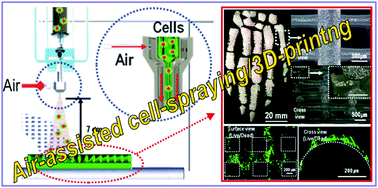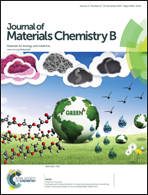Cell-encapsulating alginate microsized beads using an air-assisted atomization process to obtain a cell-laden hybrid scaffold
Abstract
The air-assisted atomization process is a method for straightforwardly spraying a liquid to obtain microsized capsules. In this study, we used the atomization process to obtain homogeneous cell-laden alginate-based microbeads for tissue regeneration. To achieve appropriate processing conditions, various weight fractions of alginate, various distances between the spraying nozzle and collector, and various applied air pressures were investigated. Through the selected conditions (3 wt% of alginate, 7 cm distance between the nozzle and collector, and 90 kPa air pressure), we prepared homogeneous microsized cell-laden beads (average diameter = 15.5 ± 6.1 μm) with reasonable cell viability (>90%). The feasibility of the sprayed microbeads was evaluated in terms of in vitro cellular activities, cell proliferation, and the morphology of the proliferating cells. In particular, the cell-sprayed microbeads showed 1.74-fold greater cell proliferation rate compared to the macro-sized cell-laden beads. Furthermore, the sprayed cell-laden alginate beads, prepared with the selected processing conditions, were combined with melt-plotted polycaprolactone struts to obtain a new hybrid scaffold. The cells in the hybrid scaffold were viable and proliferated well over several culture periods.


 Please wait while we load your content...
Please wait while we load your content...